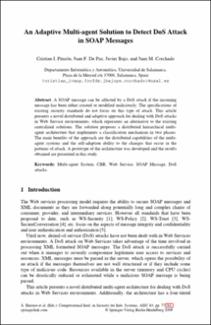Mostrar el registro sencillo del ítem
An Adaptive Multi-agent Solution to Detect DoS Attack in SOAP Messages
| dc.contributor.author | Pinzón Trejos, Cristian | |
| dc.contributor.author | De Paz, Juan | |
| dc.contributor.author | Bajo, Javier | |
| dc.contributor.author | Corchado, Juan | |
| dc.date.accessioned | 2018-06-06T19:44:54Z | |
| dc.date.accessioned | 2018-06-06T19:44:54Z | |
| dc.date.available | 2018-06-06T19:44:54Z | |
| dc.date.available | 2018-06-06T19:44:54Z | |
| dc.date.issued | 2009-07-01 | |
| dc.date.issued | 2009-07-01 | |
| dc.identifier.uri | http://ridda2.utp.ac.pa/handle/123456789/4799 | |
| dc.identifier.uri | http://ridda2.utp.ac.pa/handle/123456789/4799 | |
| dc.description | A SOAP message can be affected by a DoS attack if the incoming message has been either created or modified maliciously. The specifications of existing security standards do not focus on this type of attack. This article presents a novel distributed and adaptive approach for dealing with DoS attacks in Web Service environments, which represents an alternative to the existing centralized solutions. The solution proposes a distributed hierarchical multi-agent architecture that implements a classification mechanism in two phases. The main benefits of the approach are the distributed capabilities of the multi-agent systems and the self-adaption ability to the changes that occur in the patterns of attack. A prototype of the architecture was developed and the results obtained are presented in this study. | en_US |
| dc.description.abstract | A SOAP message can be affected by a DoS attack if the incoming message has been either created or modified maliciously. The specifications of existing security standards do not focus on this type of attack. This article presents a novel distributed and adaptive approach for dealing with DoS attacks in Web Service environments, which represents an alternative to the existing centralized solutions. The solution proposes a distributed hierarchical multi-agent architecture that implements a classification mechanism in two phases. The main benefits of the approach are the distributed capabilities of the multi-agent systems and the self-adaption ability to the changes that occur in the patterns of attack. A prototype of the architecture was developed and the results obtained are presented in this study. | en_US |
| dc.format | application/pdf | |
| dc.language | eng | |
| dc.language.iso | eng | en_US |
| dc.rights | https://creativecommons.org/licenses/by-nc-sa/4.0/ | |
| dc.rights | info:eu-repo/semantics/openAccess | |
| dc.subject | CBR | en_US |
| dc.subject | Multi-agent system | en_US |
| dc.subject | Web Services | en_US |
| dc.subject | SOAP message | en_US |
| dc.subject | DoS Attack | en_US |
| dc.subject | CBR | |
| dc.subject | Multi-agent system | |
| dc.subject | Web Services | |
| dc.subject | SOAP message | |
| dc.subject | DoS Attack | |
| dc.title | An Adaptive Multi-agent Solution to Detect DoS Attack in SOAP Messages | en_US |
| dc.type | info:eu-repo/semantics/article | |
| dc.type | info:eu-repo/semantics/publishedVersion |
